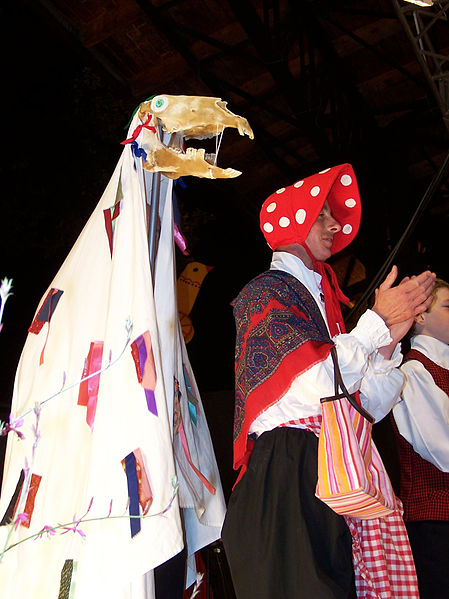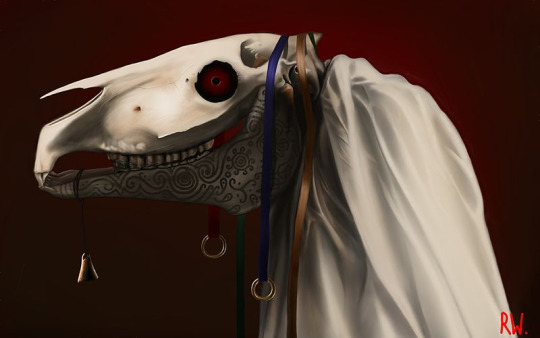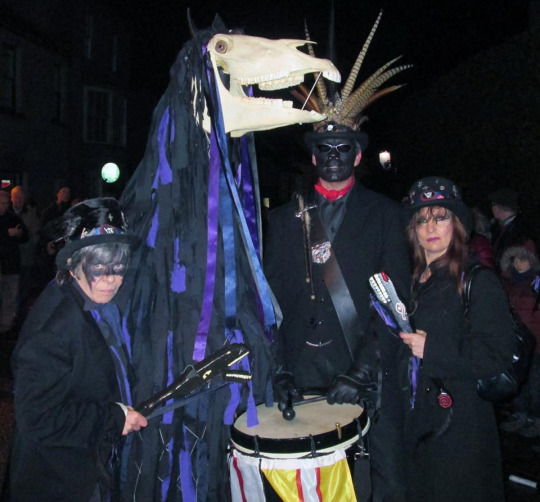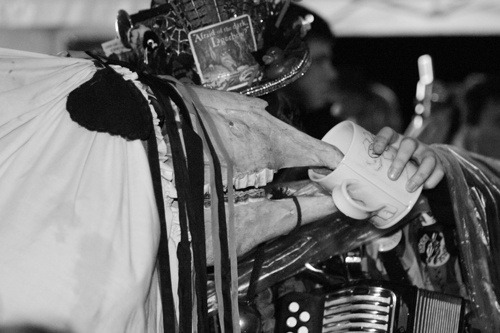#mari lywd answers
Note
the mari lwyd is the ultimate booper (knocking doors) 😅

#Hey I got get my free food and drink somehow#mari lwyd#mari lywd answers#boop boop#the boopening#boop
6 notes
·
View notes
Text
Welsh Tradition
(Inspired by Mari Lwyn, which is a Welsh holiday. Apologies if I get stuff wrong, I’m just an ignorant American writing fantasy Space Orcs stuff. No offense or appropriation is intended.)
On many a door stoop have I sung come Christmas. Aye, I’m a caroler...of sorts. I’ve been doing this for many a year. Instead of a songbook, I have a horse skull for a head. Did I mention I’m an ancient pagan spirit? I’ve been doing this since Christmas was called Yule. No, I’m not Satan or the Krampus. I get that a lot, but it gets tiring being mistaken for a baby-eating cannibal or an actual demon by non-Welsh people.
Fortunately, I fit in right here in Wales, as my carols have sparked Mari Lwyd, a tradition named after me in which carolers in horse-skull-head costumes go door to door and engage in a battle of rhymes with home owners. If the caroler wins, they get all the booze and food in the house. And yes, that was my idea. And thanks to the Internet, word of this tradition has spread far and wide.
And that, in turn, led to the tale I’m about to tell you.
So, I’m going door to door one snowy Christmas, as usual, when I notice that a house that’s usually empty in the winter has a car in the driveway. Curious, I knock. The door is answered by a guy in a star-spangled T-shirt. He is clearly an American as nobody else would be seen wearing something like that. I briefly am disappointed to find the house’s occupant to be a tourist, until he grins at me and starts singing. It seems he knows of Mari Lwyd! What luck!
His first verse went like this:
“Oh Mari Lywd spirit,
I don’t drink spirits,
Not vodka, whiskey, wine or gin,
I do have some beer, though,
Don’t wanna seem a weirdo,
But I can’t just simply let you in!”
Impressed with his singing voice and talent for improvisation, I responded in turn:
“Oh little human, from across the sea,
You seem to know well of me,
But not well enough, you see,
For if you truly knew of me,
You’d know I’ll eat your food as well,
A burger or two would be swell!”
He grinned wider and responded:
“Well, I just arrived last night,
Vacation house and a red eye flight,
The pantry bare of every can,
Save for the beer my friends bought me,
It’s a popular American brand,
And because it’s expensive over here,
I can’t just toss it, you see,
So I’ve come up with a plan: You can have the beer!”
I was taken aback. He’s just letting me have the beer? I continued in song:
“Little human, be that as it may,
Why do you do this
And not drive me away?
People ‘round here look at me askew,
Are protective of their microbrew,
And covetous of the smaller batch,
So I gotta ask: What’s the catch?”
The American grinned wider (if that was even possible), and belted out a response.
“The beer is one I love to hate,
And is the topic of much debate,
And over there it freely flows,
But I don’t think
You want it, though!”
WHAT?! Does he underestimate me? Does he underestimate my booze tolerance?? I’m literally the booze fairy! Gritting my bony teeth, I respond:
“Little human, I do not think
You know just whom
You offer drink,
Mari Lywd is what they call
To the heavens when I’ve broken in
And drank it all,
All their beer and gin.
So do not trifle with whom you’re honoring,
And do not underestimate my tolerance,
Little human, I implore
You to open up the door!”
The American frowned, paused for a second, and then started singing again:
“OK, I can see now that
A caroler you ain’t
I’m not sure quite what you are,
A devil or a saint,
But one thing that I promise you,
My offer of beer still rings true,
OK, you got me, I'll allow you this,
But a word of forewarning,
It tastes like horse piss!”
He then stops singing, and says “Uh, no offense.” in a sotto voice before breaking back into song.
"Budweiser beer,
Here comes the king,
Straight into
The guillotine,
Away with you!
You can have it!
Honestly, glad
To be rid of it!"
The human then produces a six-pack of beer, presses it into my claws, and shuts the door. Confused but mollified, I wander off to a nearby clearing and open one of the bottles with my claws. I take a big swig...And immediately start coughing. This stuff tastes awful! That human scammed me!
Furious at the betrayal, I march back up to his doorstep and demand an explanation. The smug bastard has only this to say:
“I warned you.”
#humans are insane#humans are the odd ones#humans are space orcs#no I don't like Budweiser#How did you guess?#fantasy#mari lwyd#humans baffle fae#fae folk
48 notes
·
View notes
Note
hi! do you mind explaining the tradition behind Mari Lywd?
I love this ask because it’s such a polite way of going EXPLAIN THAT POST ELANOR
EXPLAIN YOURSELF
EXPLAIN YOUR PEOPLE
I’m not sure if you’re after the history of the thing, or the actual practice of it, since ‘tradition’ could cover either - so, I’ll give you both, and hopefully your answer will be in here somewhere. I will also include more Frightening Images of the Mari Lwyd because you can never have too many horrifying photos of ornery skull-masked winter horse demons to scare the tits off you.
Okay, so. The Mari Lwyd.

Now, the first concrete recorded incidences of the Mari are from the late 1700s/early 1800s, but as with a lot of Welsh history, that’s misleading. We didn’t write a lot of our own shit like this down for much the same reason that Egypt never mentioned where to find Punt, and the English didn’t generally travel into Wales much if they could help it. Given that it seems to fold into a lot of other older traditions, though (the Hooded Animal, the Mast Beast, etc), and those have pre-Christian roots, I believe there’s a theory that it might have its roots in worshipping Rhiannon, the Welsh version of Epona, the pan-Celtic horse goddess. But there’s no way to be sure.
The meaning of the name is disputed. It’s generally accepted to mean “Grey Mare”. For a while some people thought it meant “Holy/Blessed Mary”, as in, y’know, the Virgin Mary, but this is no longer accepted because
“Llwyd” means grey, not white, and “gwen” is the colour normally used to also mean pure or holy; grey would be more likely to mean venerable/wise, which the Mari Lwyd ain’t;
I think there’s reference to ‘Mari’ being used for ‘Mary’ (instead of ‘Mair’) in the Black Book of Carmarthen, so at least since the 14th century, but that was likely only by poets - there’s no record of common folk using it before the Protestants came and reformed everything, so it seems unlikely that it could have been the original name; and
As far as I am aware there is no record of the religio-historical figure of the Virgin Mary mounting the donkey’s head on a stick and hammering down the door to the inn with a half-empty bottle of gin in one hand while scream-singing insults at the innkeeper so he’d give her cheese.
So, it’s generally accepted now that the connotations with Christian Marian symbolism are part coincidence and part encouraged among the clergy post-Reformation so that everyone could keep getting blind drunk with a horse’s skull and calling each other a willy. Plus, both Ireland and the Isle of Mann have very old hooded horse traditions too, called the Láir Bhán and the Laare Vane in Irish and Manx respectively. Both meaning, surprise surprise, the “white/grey mare”. Given that Wales and Ireland had a lot of historical interaction, this seems like more than coincidence.
Plus, you know, it is kind of a grey mare. Bones are white.

It did have other names in some places, mind - I think Carmarthenshire had some weird name for it, like Y March or y Gynfas-Farch, but you mustn’t ever listen to people from West Wales because then there would we be? Calling woodlice ‘pennysawls’ and claiming the word “Wi’n” is an acceptable variation of the verb “to be”, that’s where.
Anyway. Once upon a time, this was seemingly a mid-winter celebration in Wales, which then became a Christmas celebration until the Church went “You’re doing WHAT” and it became New Year instead. But, it did vary when different villages would do it. Some would do it on New Year, some at Christmas, some in that weird week in between when you don’t know if the bins are going out or not… You get the idea. These days, it’s New Year, as a rule.
Now, Europe does have a lot of varying traditions of doing this shit - google ‘mast beast’ for exciting photos. But usually, the beast is made by someone bending over beneath the sheet to make it look, you know, like the beast they’re mimicking. The Mari Lwyd stands out because, alone of all of them, she stands up straight, and is seven feet tall. She is the tallest of all the mast beasts. In a country where the average female height is 5'4", and men not much taller, that makes her fuck-damned enormous.

So, with that out of the way, let me tell you how it goes!
Traditionally, making the Mari is an important part of the whole thing - most villages would have a set skull they’d use, like, but the decoration was a week-long community affair, because as we all know, it would be creepy if you just stuck a skull on a pole oh my god. You have to put ribbons and glass eyes on it! That stops it being creepy! Obviously!

(Also, as a side note, battery-powered fairy lights have been a gift to the Mari Lwyd.)
youtube
The skulls, incidentally, were almost always from a beloved village horse who had at some point died at a ripe old age, and then whose skull was taken to live on as the Mari. Most villages knew their names, decades later. Down the Gower peninsula I think there was one account, mind, that they used to bury the skull for the rest of the year, and just dig it up in time for the Mari. But most kept it in a cupboard, like. Next to the sugar. I dunno. An important point, though - the skulls are also rigged so the person inside can snap the jaw, and incidentally, few things in this infinite and wondrous existence are as creepy and low-key primally unnerving as hearing ten of these things around you snapping in the dark, just btw, just fyi.
Anyway; you’ve spent a week decorating! (Although these days they’re kept pre-decorated.) What now?
The Mari party gathers at about midday. That’s the Mari herself, plus others - it varies who, but classically, I think they dressed up as Punch and Judy characters, those being the mischievous comedy extravaganza of the day. Then they start at one end of the village and go to the first house, where they sing Cân y Fari. That’s a bit like yelling ‘Trick or treat’, except rather than asking for sweets, they’re after delicious alcohol and cheese (side note: Wales’ relationship with cheese goes beyond Peak White Person and out the other side into What Is Wrong With You People. We have myths and folklore about it. It is Very Important.)
Now, the house holders do not want to give away their delicious alcohol and cheese, and so at this point, they begin something called the Pwnco (the ‘w’ is pronounced like the 'oo’ in 'book’, while the 'o’ is short like in 'hot’.) The Pwnco is, like… sort of like a rap battle? But sung. But that’s the idea. It’s beautifully poetic, and almost always opens with the same very nice verse, to whit:
Wel dyma ni'n diwad (Well here we come)Gyfeillion diniwad (Innocent friends)I ofyn am gennad (To ask leave)I ofyn am gennad (To ask leave)I ofyn am gennad i ganu (To ask leave to sing)
which you can hear a bit of here; I filmed that in Llangynnwyd. But, it’s very much a “So’s your FACE” type of thing. The householders tell the Mari to get straight to fuck, and then the Mari responds in kind. And they go back and forth until one side loses.
Now, if the Mari loses, she goes to the next house. But if the householders lose, they have to let her in and give her their delicious alcohol and cheese. IMPORTANT STEP, HOWEVER: if they have a bare ounce of sense between them, they first make her promise to behave before letting her past the door. Because if they don’t, HA HA all hell breaks loose, and the party do as much mischief as they can, like smearing ash on your walls and stealing your goats and mixing your white laundry in with your colours and hiding your drawing tablet pens. It is a Riot.
Anyway, once done, they leave the tattered ruins of your former house, go to the next house, and start again. More delicious alcohol and cheese!
It all got banned by the Welsh Non-Conformist Church of No Fun ever, because rival Mari parties would get blind drunk and then fight each other in the streets. It started to die out in the 50s, though some smaller villages kept it going - Llangynnwyd never even stopped. And in the last two decades it’s started making a resurgence in places like Brecon, Llantrisant, etc - tonnes of places in the belt between Vale and mountains, really, which makes me think it’s because the Folk Museum is in St Ffagans.
But Chepstow do a modern twist - the town is right on the border with England, so they do a festival of Welsh Mari Lwyd and English morris dancing combined in mid-January each year. Turns out, every goddamn Mari in the country comes to it, too, which is why this year I got to see 24 Mari Lwyds. I had NO IDEA. So, so many Maris...
It also used to sometimes get mixed in with other festive cheese-begging traditions like Calennig, but it is pretty much separate. As a final question: why do it? Well... we dunno. The purpose of the uppity skeletal horse beast is unknown at this point. Like I say, it may well have been a Rhiannon thing; given the way it got folded into some Christian things post-Reformation, it may have absorbed some form of fleeing-on-a-donkey-to-give-birth stuff. It’s hard to even nail down distribution patterns. But, something I find interesting about its distribution is that it was predominantly done in areas that either mined, smelted or sold minerals a lot. Make of that what you will.
And, that’s the Mari Lwyd.

16K notes
·
View notes